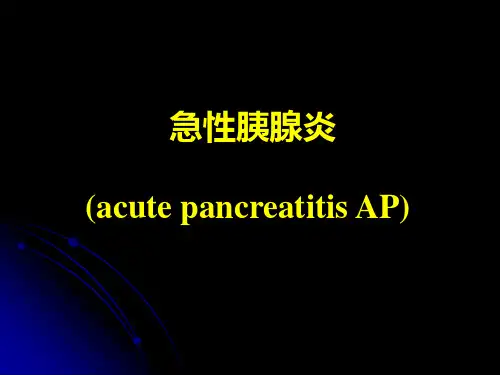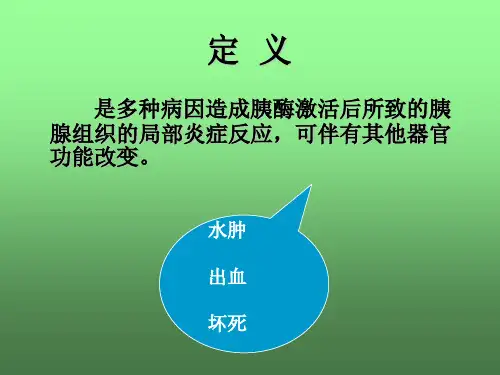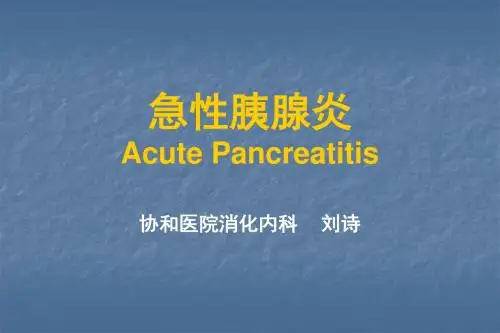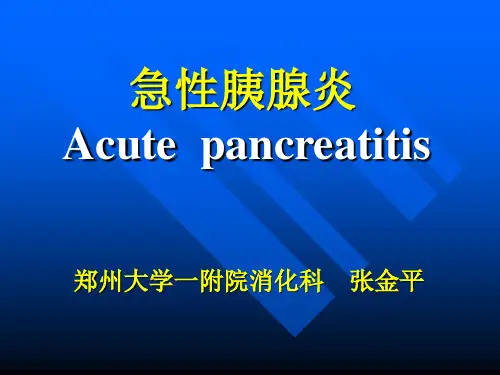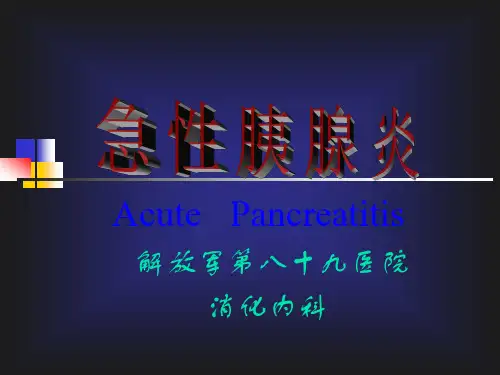篇急性胰腺炎
- 格式:ppt
- 大小:102.50 KB
- 文档页数:35
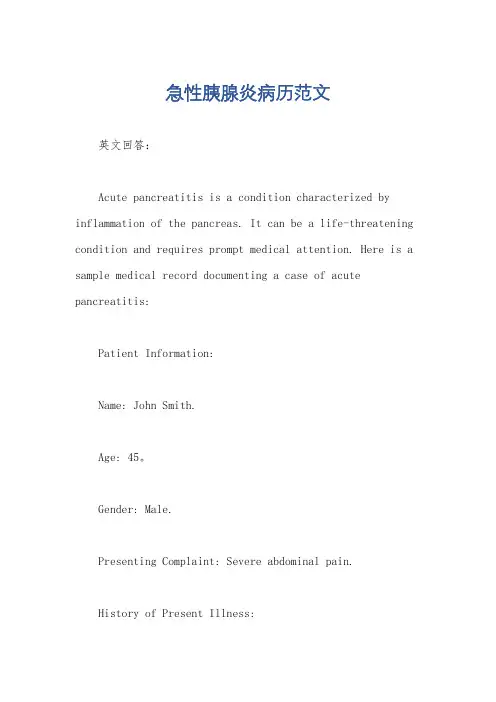
急性胰腺炎病历范文英文回答:Acute pancreatitis is a condition characterized by inflammation of the pancreas. It can be a life-threatening condition and requires prompt medical attention. Here is a sample medical record documenting a case of acute pancreatitis:Patient Information:Name: John Smith.Age: 45。
Gender: Male.Presenting Complaint: Severe abdominal pain.History of Present Illness:The patient presented to the emergency department with complaints of severe abdominal pain that started suddenly and radiated to the back. The pain was accompanied by nausea and vomiting. The patient reported a history of heavy alcohol consumption and a recent episode of binge drinking.Past Medical History:The patient has a history of chronic alcohol abuse and smoking. No previous episodes of pancreatitis have been reported.Physical Examination:On examination, the patient appeared in distress and had a tender abdomen with guarding. Blood pressure was elevated, and heart rate was increased. There were no signs of jaundice or other systemic abnormalities.Diagnostic Tests:1. Laboratory tests:Complete blood count: Elevated white blood cell count.Serum amylase and lipase levels: Markedly elevated.Liver function tests: Within normal limits.2. Imaging studies:Abdominal ultrasound: Enlarged pancreas with peripancreatic fluid collection.Diagnosis:Acute pancreatitis secondary to alcohol abuse.Treatment:The patient was admitted to the hospital and receivedaggressive fluid resuscitation. Pain management was provided with intravenous analgesics. The patient was kept nil per os (NPO) and received total parenteral nutrition. Monitoring of vital signs, urine output, and laboratory parameters was initiated. The patient was advised to abstain from alcohol and smoking.Progress:Over the next few days, the patient's abdominal pain gradually improved. Laboratory parameters, including amylase and lipase levels, started to normalize. The patient was transitioned to a clear liquid diet and later to a low-fat diet. He was discharged with instructions to follow up with a gastroenterologist and to maintain a healthy lifestyle.中文回答:急性胰腺炎是一种胰腺的炎症性疾病。

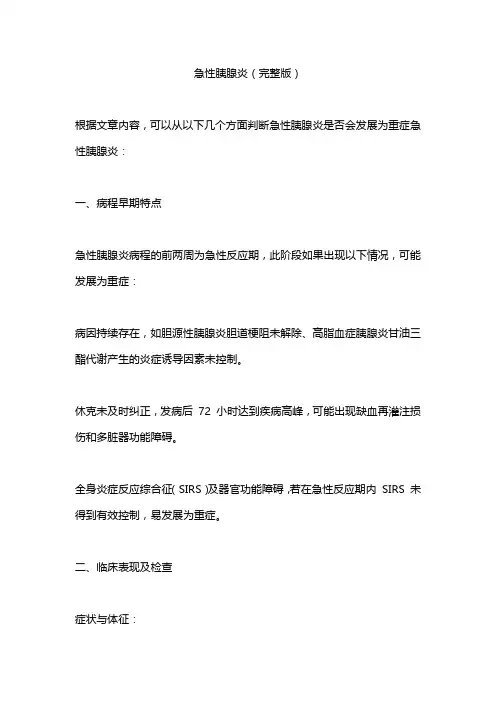
急性胰腺炎(完整版)根据文章内容,可以从以下几个方面判断急性胰腺炎是否会发展为重症急性胰腺炎:一、病程早期特点急性胰腺炎病程的前两周为急性反应期,此阶段如果出现以下情况,可能发展为重症:病因持续存在,如胆源性胰腺炎胆道梗阻未解除、高脂血症胰腺炎甘油三酯代谢产生的炎症诱导因素未控制。
休克未及时纠正,发病后72 小时达到疾病高峰,可能出现缺血再灌注损伤和多脏器功能障碍。
全身炎症反应综合征(SIRS)及器官功能障碍,若在急性反应期内SIRS 未得到有效控制,易发展为重症。
二、临床表现及检查症状与体征:患者以腹痛等症状就诊,腹痛剧烈且持续不缓解可能提示病情较重。
出现呼吸急促、心率加快等表现,如心率≥120 次/min 可能提示病情向重症发展。
腹腔压力升高表现,如出现腹胀明显、腹腔间隔室综合征等,提示可能发展为重症。
辅助检查:血淀粉酶:数值受到很多因素影响,但明显异常升高可能与病情严重程度相关。
CT 检查:从胸腔至耻骨联合的平扫CT 检查,除可作为诊断急性胰腺炎的必需条件外,有助于评估病情及指导治疗。
若CT 显示胰腺及周围组织广泛渗出、坏死等,提示可能发展为重症。
胸腔积液量多影响呼吸及需要穿刺引流,同时可间接提示腹腔渗出及感染部位严重,可能发展为重症。
三、关键诊疗措施相关指标病因处理:胆源性胰腺炎:明确胆道状态,完全梗阻型未及时解除梗阻、非完全梗阻型未处理通而不畅状态可能发展为重症。
继发无菌性胆囊炎未早期行PTGBD,可能病情加重。
高脂血症胰腺炎:甘油三酯未有效控制,脂肪酸持续产生引发强烈炎症反应,可能发展为重症。
液体复苏:若患者存在重度血容量缺乏(发病72h 内同时满足心率≥120 次/min、平均动脉压≥85mmHg 或≤60mmHg、动脉血乳酸≥4mmol/L、尿量≤0.5mL/(kg・h)、红细胞压积≥44% 三项或以上),且液体复苏效果不佳,可能发展为重症。
过度液体复苏会导致并发症增加,也可能提示病情向重症发展。
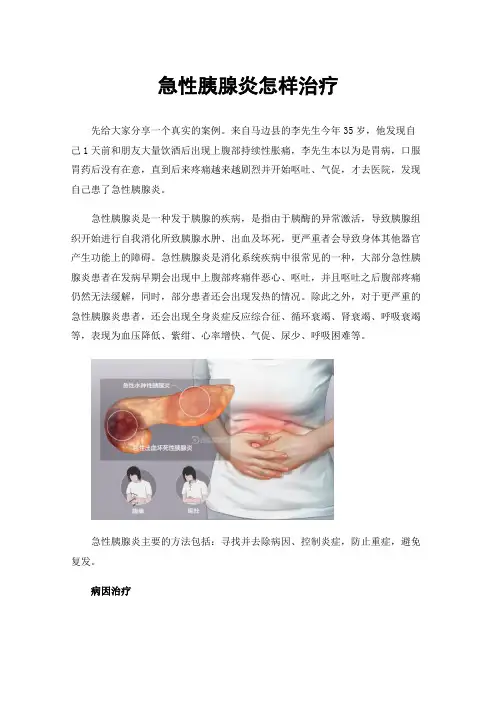
急性胰腺炎怎样治疗先给大家分享一个真实的案例。
来自马边县的李先生今年35岁,他发现自己1天前和朋友大量饮酒后出现上腹部持续性胀痛,李先生本以为是胃病,口服胃药后没有在意,直到后来疼痛越来越剧烈并开始呕吐、气促,才去医院,发现自己患了急性胰腺炎。
急性胰腺炎是一种发于胰腺的疾病,是指由于胰酶的异常激活,导致胰腺组织开始进行自我消化所致胰腺水肿、出血及坏死,更严重者会导致身体其他器官产生功能上的障碍。
急性胰腺炎是消化系统疾病中很常见的一种,大部分急性胰腺炎患者在发病早期会出现中上腹部疼痛伴恶心、呕吐,并且呕吐之后腹部疼痛仍然无法缓解,同时,部分患者还会出现发热的情况。
除此之外,对于更严重的急性胰腺炎患者,还会出现全身炎症反应综合征、循环衰竭、肾衰竭、呼吸衰竭等,表现为血压降低、紫绀、心率增快、气促、尿少、呼吸困难等。
急性胰腺炎主要的方法包括:寻找并去除病因、控制炎症,防止重症,避免复发。
病因治疗病因治疗是指针对由于各种引起急性胰腺炎原因的治疗方法。
引起急性胰腺炎的主要基础疾病包括胆道疾病、高血脂等等。
1.胆源性胰腺炎治疗胆源性胰腺炎是指由于胆道的基础疾病引起了急性胰腺炎。
针对于胆源性胰腺炎患者,比如胆总管结石、急性化脓性胆管炎、胆源性败血症等,应尽早行治疗性ERCP,内镜下Oddi括约肌切开术、取石术、放置鼻胆管等既有助于降低胰管内高压,又可迅速控制感染。
这种微创对因治疗疗效肯定,创伤小,可迅速缓解症状,改善预后,缩短病程,节省治疗费用。
1.高脂血症性胰腺炎治疗高脂血症性胰腺炎是指由于血脂过高引起了急性胰腺炎。
针对于高脂血症性胰腺炎,治疗方法应当以降低血脂为重点,包括:常规降脂药物,低分子肝素,胰岛素,血液净化(血液滤过、血液灌流、血液置换),有利于患者肺、肾、脑等重要器官功能改善和恢复,避免病情恶化。
二、器官支持1.液体复苏旨在迅速纠正组织缺氧,也是维持血容量及水、电解质平衡的重要措施。
此外还应病情补充白蛋白、血浆、血浆代用品,组织中乳酸堆积,代谢性酸中毒较常见,应积极补充碳酸氢钠。
